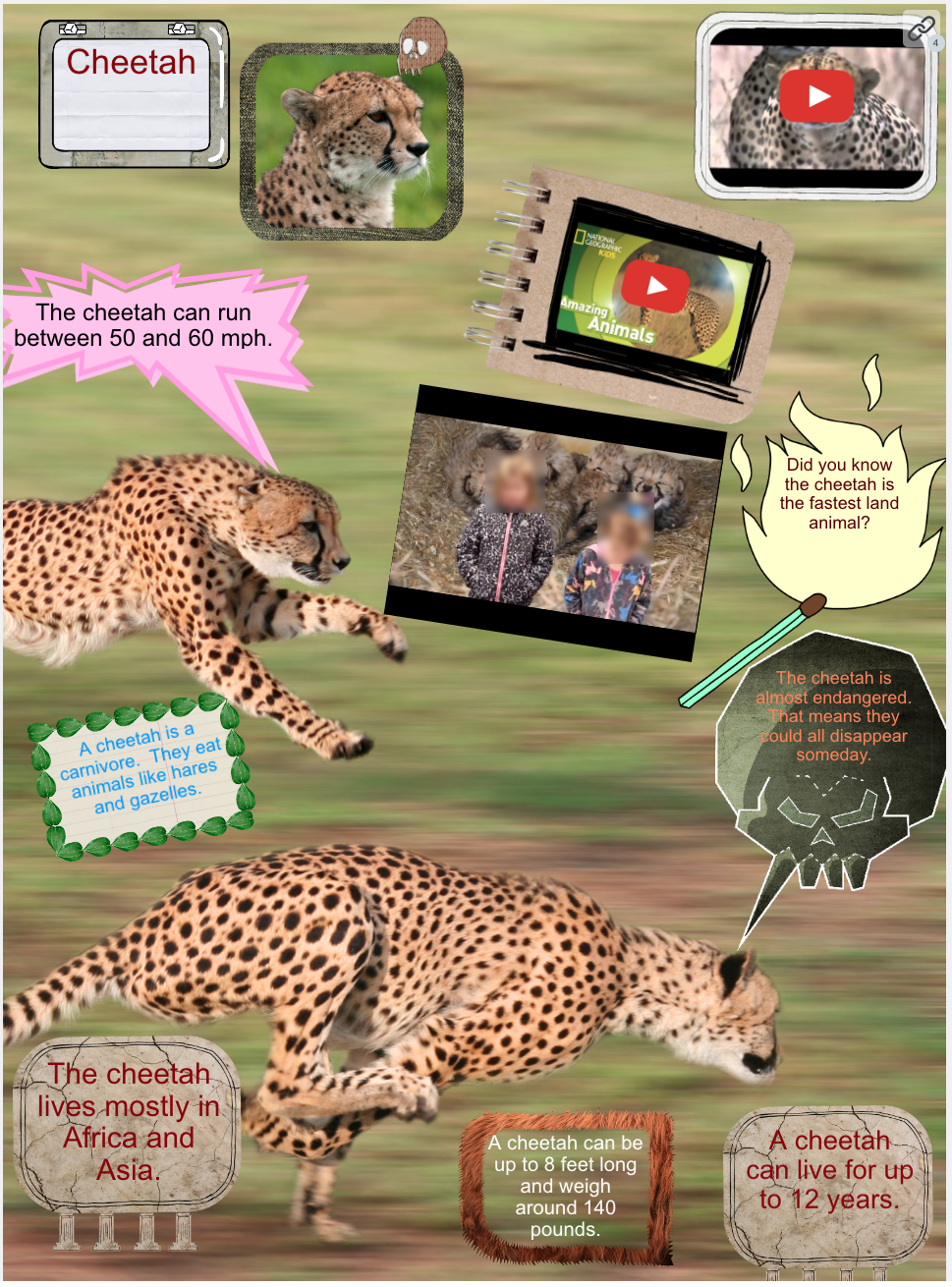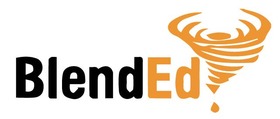Digital Age Skill: Lower Elementary - Wild Animals
Wild Animals
Description of the Lesson
Overview
Students will create an interactive poster showcasing their organization and understanding of information acquired as they research animals. Students will read and summarize information they find, and produce a poster and video as part of their project. I partner students up to complete the project.
ISTE Standard
ISTE Standard: 3C - With guidance from an educator, students explore a variety of teacher-selected tools to organize information and make connections to their learning.
NE Standard
NE Standard:2.1.4.d - Identify the importance of media arts as a learning tool.
LA 2.1.6.f Use text features to locate information and gain meaning from print and digital text.
LA 2.1.6.o Demonstrate an understanding of text via multiple mediums (e.g., writing, artistic representation, video, other media).
LA 2.2.1.c Gather and use relevant information and evidence from one or more print and/or digital sources to support ideas.
LA 2.2.1.e Revise to improve and clarify writing through self-monitoring strategies and feedback from others.
LA 2.2.1.f Provide oral and/or written descriptive feedback to other writers. LA 2.2.1.g Persevere in writing tasks of various length and complexity. LA 2.2.1.h Proofread and edit writing recursively for format and conventions of standard English (e.g., spelling, capitalization, grammar, punctuation, syntax, semantics). LA 2.2.1.i Display academic honesty and integrity by avoiding plagiarism and providing a list of sources.
LA 2.4.1 Information Fluency: Students will evaluate, create, and communicate information in a variety of media and formats (textual, visual, and digital).
LA 2.4.1.a With guidance, locate, organize, and evaluate information from print and digital resources to generate and answer questions and create new understandings.
LA 2.4.1.b With guidance, demonstrate ethical use of information and copyright guidelines by appropriately quoting or paraphrasing from a text and citing the source using available resources (e.g., online citation tools).
LA 2.4.1.c Use or decipher multiple formats of print and digital text (e.g., manuscript, font, graphics, symbols).
LA 2.4.2 Digital Citizenship: Students will practice the norms of appropriate and responsible technology use.
LA 2.4.2.a Practice safe and ethical behaviors when communicating and interacting with others digitally (e.g., safe information to share, appropriate language use, utilize appropriate sites and materials, respect diverse perspectives).
LA 2.4.2.b Use appropriate digital tools (e.g., social media, online collaborative tools, apps) to communicate with others for conveying information, gathering opinions, and solving problems.
Rubric Used for Assessment
Example Student Artifact(s)
NA

Student Example
Lesson Design Reflection
LESSON PLAN - Knowledge Constructor Lower Elementary K-2nd Grade
WILD ANIMALS
Students will create an interactive poster showcasing their organization and understanding of information acquired as they research animals. Students will read and summarize information they find, and produce a poster and video as part of their project. I partner students up to complete the project.
OBJECTIVES
Students will be able to read, summarize, and organize (animal) research into a grade level appropriate interactive poster and video to help aid their understanding as they summarize and demonstrate what they have learned.
OUTSIDE RESOURCES
Students will be using National Geographic Kids Animal Pages (https://kids.nationalgeographic.com/animals/) and Glogster (edu.glogster.com $40/year for an Elementary license with 30 student accounts). Posters can be shared online and via social media outlets once complete. Other websites can be used for presentation (such as Google Slides).
STANDARDS
State Standard(s): Nebraska Media Arts Standards
NE Standard:2.1.4.d - Identify the importance of media arts as a learning tool.
LA 2.1.6.f Use text features to locate information and gain meaning from print and digital text.
LA 2.1.6.o Demonstrate an understanding of text via multiple mediums (e.g., writing, artistic representation, video, other media).
LA 2.2.1.c Gather and use relevant information and evidence from one or more print and/or digital sources to support ideas.
LA 2.2.1.e Revise to improve and clarify writing through self-monitoring strategies and feedback from others.
LA 2.2.1.f Provide oral and/or written descriptive feedback to other writers. LA 2.2.1.g Persevere in writing tasks of various length and complexity. LA 2.2.1.h Proofread and edit writing recursively for format and conventions of standard English (e.g., spelling, capitalization, grammar, punctuation, syntax, semantics). LA 2.2.1.i Display academic honesty and integrity by avoiding plagiarism and providing a list of sources.
LA 2.4.1 Information Fluency: Students will evaluate, create, and communicate information in a variety of media and formats (textual, visual, and digital).
LA 2.4.1.a With guidance, locate, organize, and evaluate information from print and digital resources to generate and answer questions and create new understandings.
LA 2.4.1.b With guidance, demonstrate ethical use of information and copyright guidelines by appropriately quoting or paraphrasing from a text and citing the source using available resources (e.g., online citation tools).
LA 2.4.1.c Use or decipher multiple formats of print and digital text (e.g., manuscript, font, graphics, symbols).
LA 2.4.2 Digital Citizenship: Students will practice the norms of appropriate and responsible technology use.
LA 2.4.2.a Practice safe and ethical behaviors when communicating and interacting with others digitally (e.g., safe information to share, appropriate language use, utilize appropriate sites and materials, respect diverse perspectives).
LA 2.4.2.b Use appropriate digital tools (e.g., social media, online collaborative tools, apps) to communicate with others for conveying information, gathering opinions, and solving problems.
ISTE Standard(s):
ISTE Standard: 3C - With guidance from an educator, students explore a variety of teacher-selected tools to organize information and make connections to their learning.
HOOK/ATTENTION GETTER
*To help grab student interest, the teacher created example (Cheetahs) will be shared with the class via a projector to show what the final project can look like. Students will have an opportunity to look at it individually on their own devices as well to interact with the poster on their own time.
The YouTube video from National Geographic on Cheetahs could be shown to the whole class if each student is not able to watch individually as well. https://www.youtube.com/watch?v=N7e_lDDojas
The green screen can be demonstrated live to build student excitement as the tablet can be mirrored onto a projector or faced so the students see the screen as they record. The Do Ink app has the ability to replace the green screen image live so the students can see what their video will look like.
STUDENT INSTRUCTIONS
*Students viewed the poster on their individual devices and were able to watch the YouTube videos as well to better understand the project. After viewing the initial poster, students are presented with the question “Do you have a favorite wild animal?” Students were tasked to create a list of questions they wanted to investigate about their favorite animal and questions they felt they would need to answer in order to complete the project.
Students were given a graphic organizer and writing instruments to organize their thoughts. They were also given access to National Geographic Kids (https://kids.nationalgeographic.com/animals/) Glogser (assigned username to login at edu.glogster.com).
DIRECT INSTRUCTION & GUIDED PRACTICE
*This lesson is meant to be guided by teacher providing examples via direct instruction, and students then working independently with teacher assistance as needed to complete each task. Each step is meant to be modeled as it is introduced and additional examples are provided throughout the process.
Students will use National Geographic Kids (https://kids.nationalgeographic.com/animals/) to select an animal to research. Once an animal has been selected, students will read and summarize information they have learned using a graphic organizer to include the name of their animal, along with 6 facts (or more) about their animal. Facts will be chosen by the students and are to be written in complete sentences with correct spelling and capitalization.
Teacher will model how to read and summarize information to write facts on their graphic organizer in full sentences.
Students will work on their own to read and summarize information into complete sentences.
Once students have the graphic organizer complete, they will create a poster using Gloster (edu.glogster.com).
The teacher will model the initial creation and layout of a poster on Glogster by inserting seven text boxes, moving and resizing, and saving.
Students will insert their seven text boxes to type their animal facts and poster title. One box will be their title, and the other six will contain one fact per box. Facts may be two sentences long or as long as needed. Students will move text boxes around the poster throughout the process as they continue the design process.
Images will be added to the poster to show photos of their chosen animal. One image needs to be added as the main background or wall image.
Teacher will model how to search for and add images using the built in tools and reinforcing using images that are either free for reuse or that come directly from National Geographic where they can be credited in a text box at the bottom of the poster.
Students will insert images of their chosen animal and resize and move as needed. They may also add decorations and frames as needed.
YouTube videos will be added for their animal to provide additional information and to add quality content to their poster.
Teacher will model using the built in YouTube search feature on Glogster and insert a video for their animal.
Students will search for, preview, and select videos that are appropriate and less than 10 minutes in length. They may also add frames to their videos as desired.
Green screen videos will be created of students sharing what they have learned. Using a green screen background, students will use the facts from their graphic organizer to create a video of themselves sharing their facts and what they have learned about their animal.
The teacher will demonstrate how to use a physical green screen along with the Green Screen by Do Ink app to record a video with an image of the chosen animal in the background. If possible, the tablet should be mirrored to a projector so the students can watch the tablet screen as the teacher walks through the example.
Students will save their animal image to the tablet, decide which facts they are responsible to share, then record their video. Other students in the class will run the tablet for recording.
The video will be uploaded to YouTube (listed as private) and embedded as part of their poster.
Green screen recording will be done with a green wall, tablet, Green Screen app by Do Ink, tripod with tablet holder, and an external microphone for better sound quality.
If privacy concerns were an issue, students could select an app (Voki, Tellagami, etc.) that would allow for avatars to be used instead of their actual faces.
WRAP UP
*As a culmination of this project, the teacher will create a list of all student posters for viewing by other students and staff and hosting a viewing party where students can spend time watching other student videos and interacting with the other work created.
*The posters can also be shared on social media or through school media outlets depending on school policy.
Personal Reflection
Overall I think the lesson went well. Having students work in partners did seem to help as they caught and corrected many mistakes without my help. It is a lesson that will constantly need re-evaluated and tailored to each group. I think spending more time on summarizing information with some prior exercises might help as well as making the graphic organizer larger and double sided.
